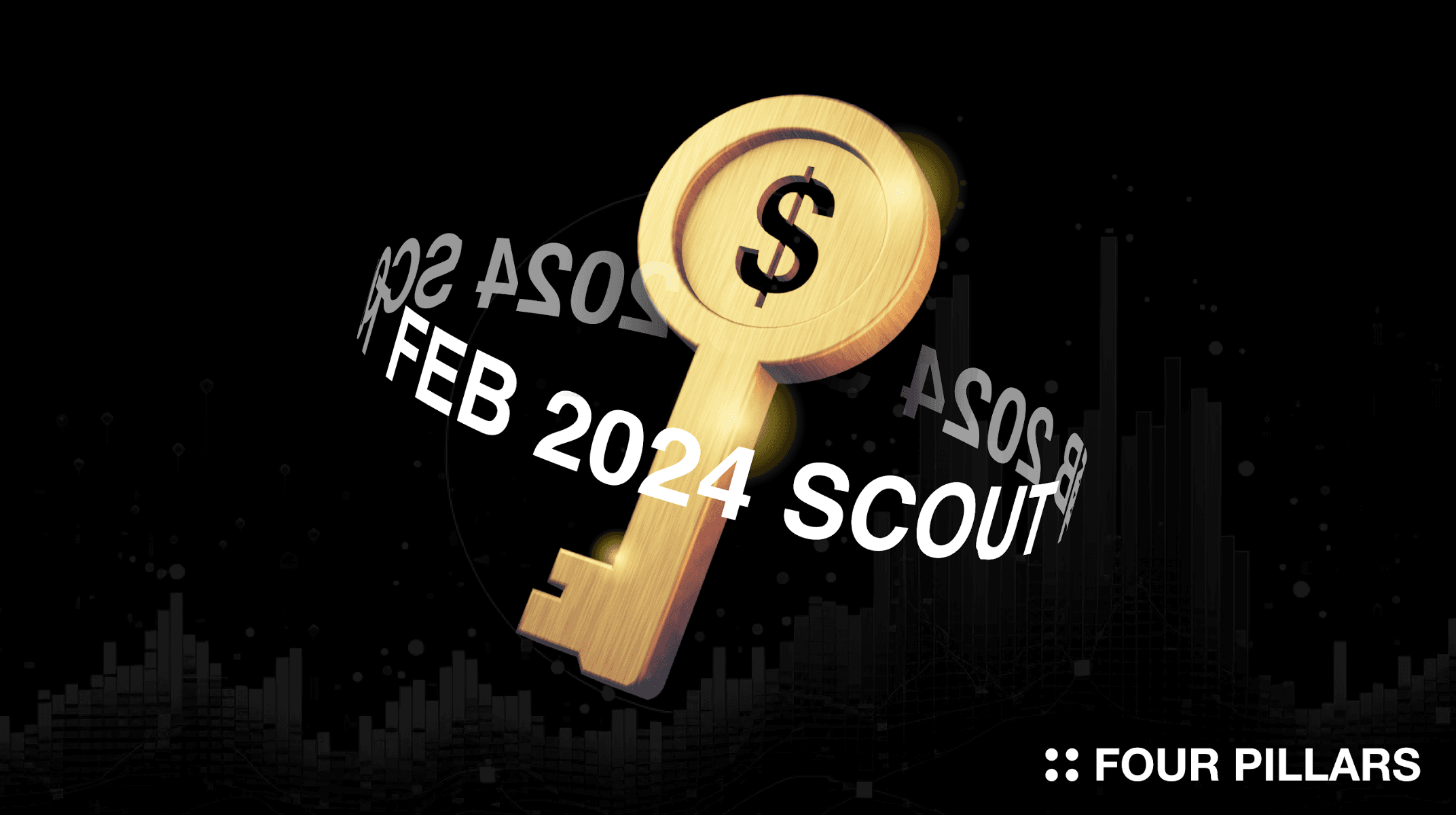
‘{Proof of X | X; Work, Stake, or other actions}’
What makes blockchains revolutionary is their ability to facilitate open and voluntary participation from an arbitrary number of people, thereby enhancing the system's resilience. The term 'decentralization,' derived from this fundamental philosophy of blockchains, relates to discussions about the degree of dependency on centralized entities, and it seems to have become a key characteristic of the whole blockchain ecosystem.
Of course, decentralization still remains a spectral and abstract concept with almost no explicit indicators to measure it. Consequently, there is no consensus on what constitutes an 'adequately decentralized' state. However, it is clear that 1) as one moves from the application (or product) level to the infrastructure level, protocols emphasize decentralized operations along with credible neutrality more, and 2) most infrastructure protocols are gradually moving towards a more decentralized environment as their goal.
Ethereum, facing the Dencun update as a significant milestone in its rollup-centric roadmap, is lowering barriers to node entry by switching from Merkle trees to Verkle trees in its data structure, and simplifying the protocol to implement stateless clients by expiring old records and states during The Verge and The Purge phases. Even Solana, despite being highly decentralized in terms of full nodes but criticized for centralization due to high hardware specifications, is planning its roadmap to allow validators to participate more easily and in greater numbers as hardware becomes cheaper, following Moore's Law. Similarly, most DPoS-based protocols are gradually increasing the number of active validators set while maintaining their performance through various updates.
However, simply following such roadmaps does not lead to the result that the number of node operators will increase and decentralization will improve drastically, as operating a node encompasses complex difficulties beyond what protocols can strive for.
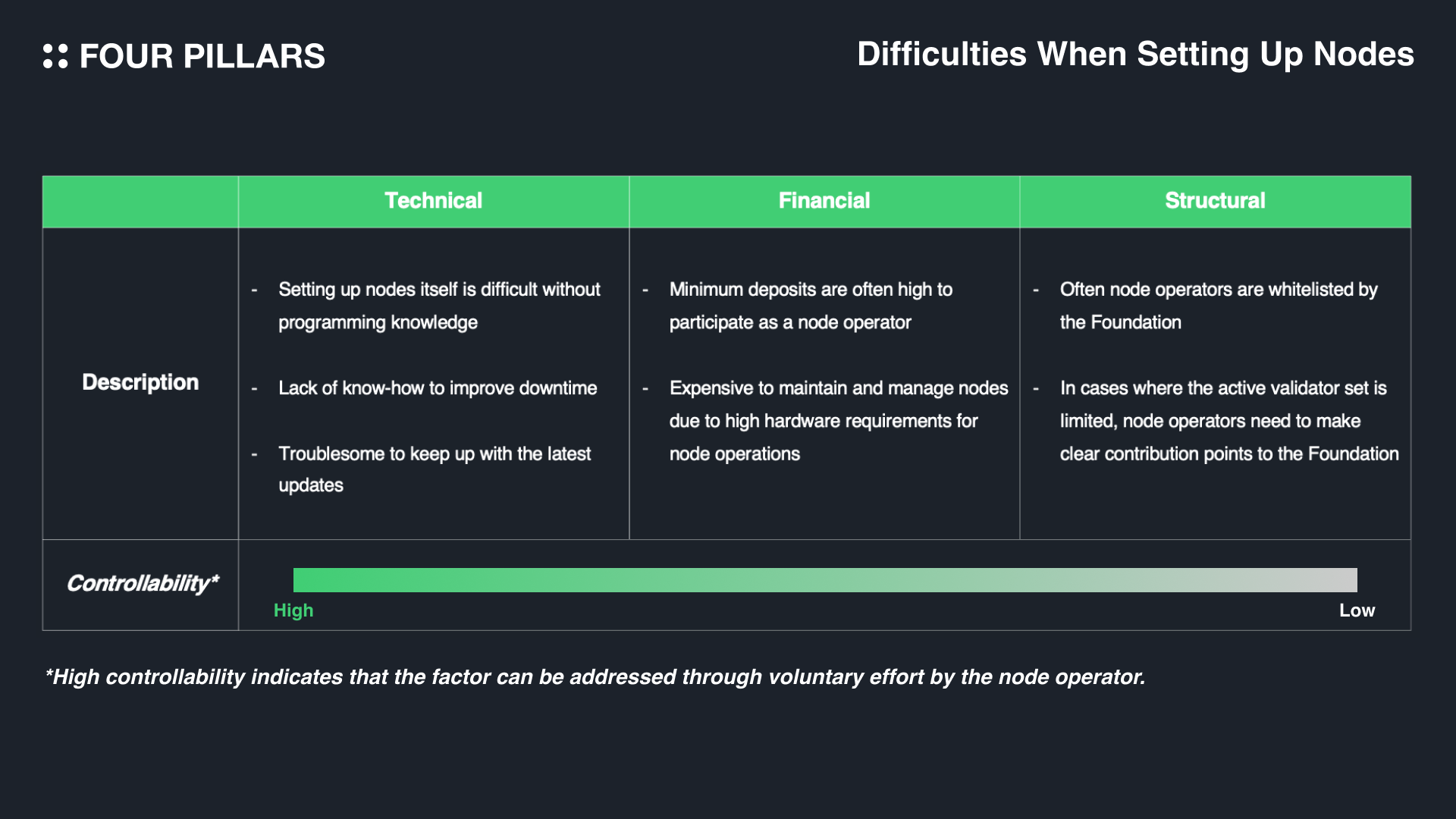
From the perspective of participants, the more uncontrollable non-technical factors are, the ecosystem itself is trying to facilitate various forms of participation (e.g., supporting staking pools, delegating tokens, etc). Yet, this is merely a short-term solution that shifts the responsibility of decentralization to other operational entities, without fundamentally solving the inherent centralization issues within the ecosystem - concerns about the dominance of Staked ETH by Lido have been longstanding and are likely to continue.
In essence, if the level of decentralization each protocol aspires to achieve is indeed improving, then a variety of solutions, considering all technical, financial, and structural aspects, must emerge. Especially, solutions that lower technical barriers to enable new participants to 'voluntarily' contribute to network operation need to be more prevalent - the recent discussions about Distributed Validator Technology (DVT)* are in this context. Not only are general-purpose blockchains like Ethereum and Solana evolving, but also modular blockchains or distributed GPU projects, and DePIN for specific purposes are emerging, indicating a diversification in how data is structured, validated, and circulated. This diversification could lead to a wide variety of node types and participant numbers required by each protocol**.
Following this, the next section will introduce projects aimed at significantly lowering the technical barriers for node setup and operation. These projects could contribute to improving the ecosystem's decentralization and offer better staking returns for regular users unfamiliar with programming. They could also assist product builders in focusing on core business logic without worrying about the complexities of node operation.
*Distributed Validator Technology (DVT) is a technology where multiple individuals share validator keys to create an Active-Active redundancy architecture. By operating a common node under a consensus by a small cluster, it is expected to significantly improve downtime and lower the entry barriers for node operation, making it accessible even to non-expert validators (e.g., solo validators).
**In cases where decentralization cannot be compromised for performance, there are many instances where specific functions and their corresponding entities are completely separated to decentralize the network (e.g., Ethereum’s PBS for MEV Decentralization, Celestia’s DAS & Solana’s Tiny Dancer for Verifying Nodes’ Decentralization, etc.).
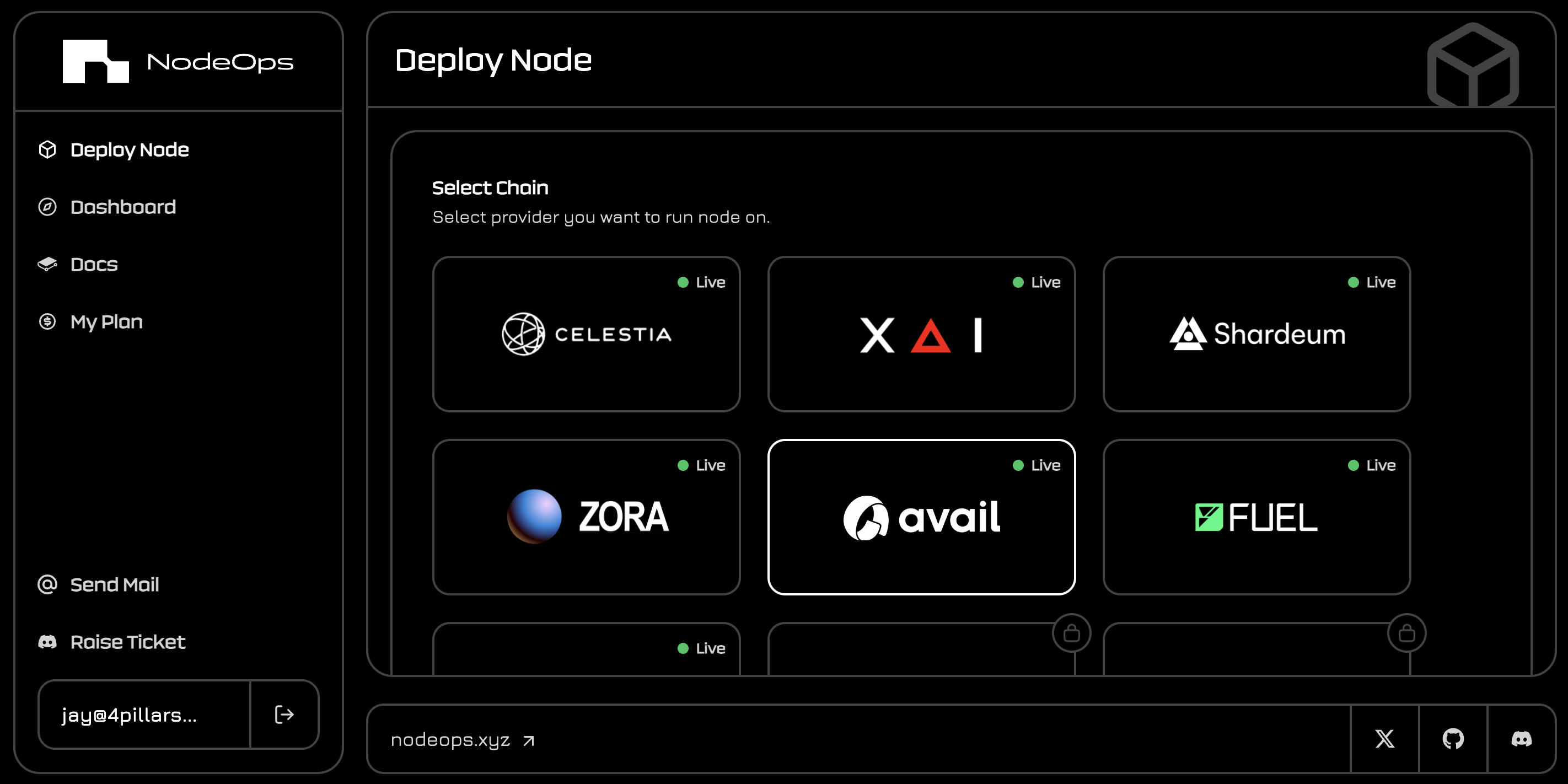
Source: NodeOps Console
NodeOps offers participants and developers the ability to set up nodes effortlessly through the NodeOps Console, providing preset templates that require no additional setup and just a few clicks. As of today (6th, March), it supports seven protocols: Celestia, XAI, Shardeum, Zora, Avail, Fuel, and Powerloom, with each protocol requiring various types of nodes such as validator nodes, full nodes, light nodes or RPC nodes, archive nodes, etc.
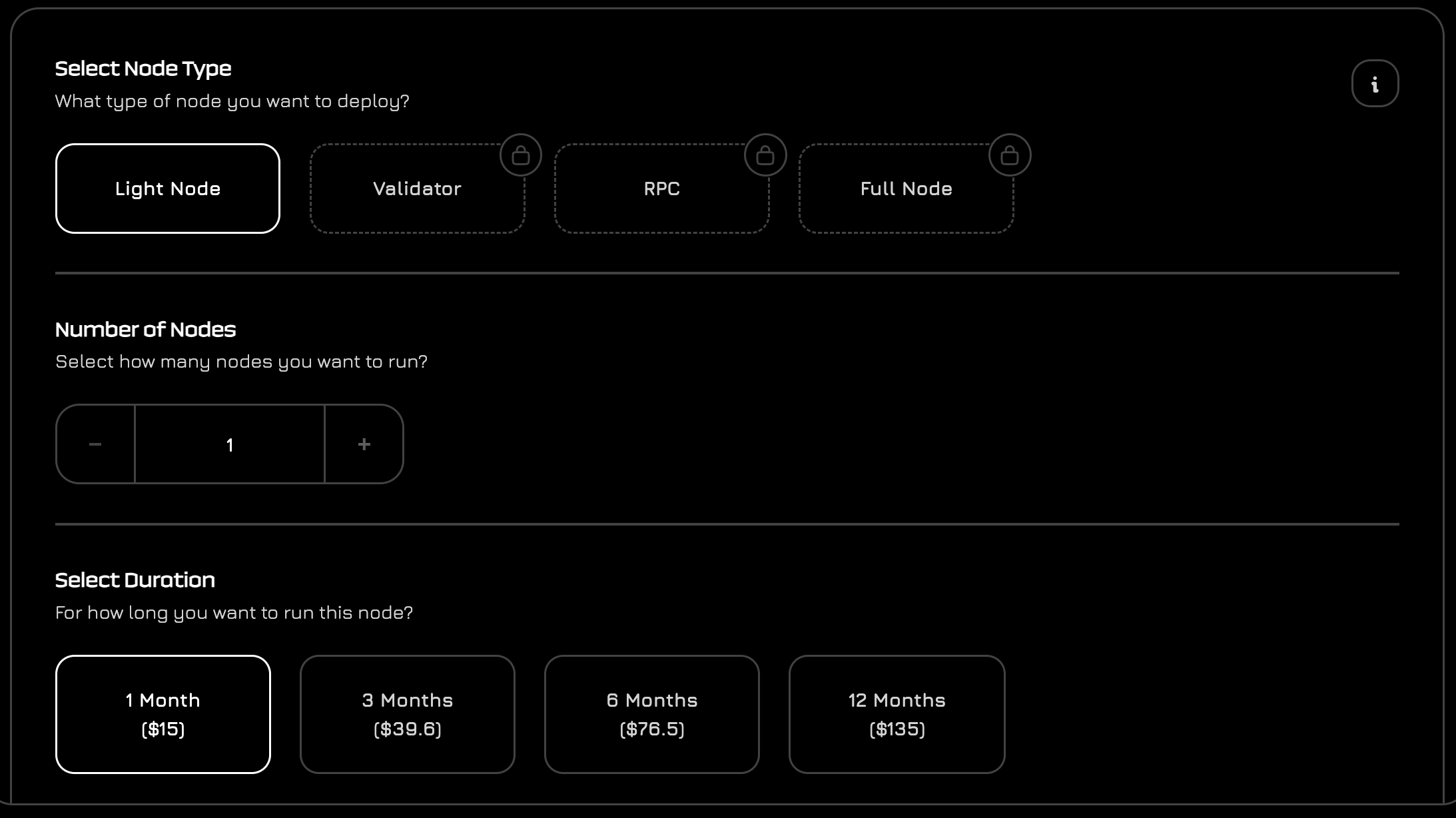
Source: NodeOps Console
Assuming users have the necessary keys for their node operations, the entire process for setting up nodes across the protocols supported by NodeOps varies slightly but generally follows three steps: “1) Sign up, 2) Select a protocol and configure the node setup, 3) Pay the periodic operation fees using fiat or cryptocurrencies (e.g., $USDT, $MATIC, $USDC, $ETH)”. In some cases, if supported by NodeOps, nodes deployed in other environments can be migrated to NodeOps (e.g., XAI’s sentry node).
Nodes deployed via NodeOps can be monitored on the Console's dashboard, where users can also access detailed information about each operational node and use codebase monitoring tools to check for vulnerabilities among other operational statuses.
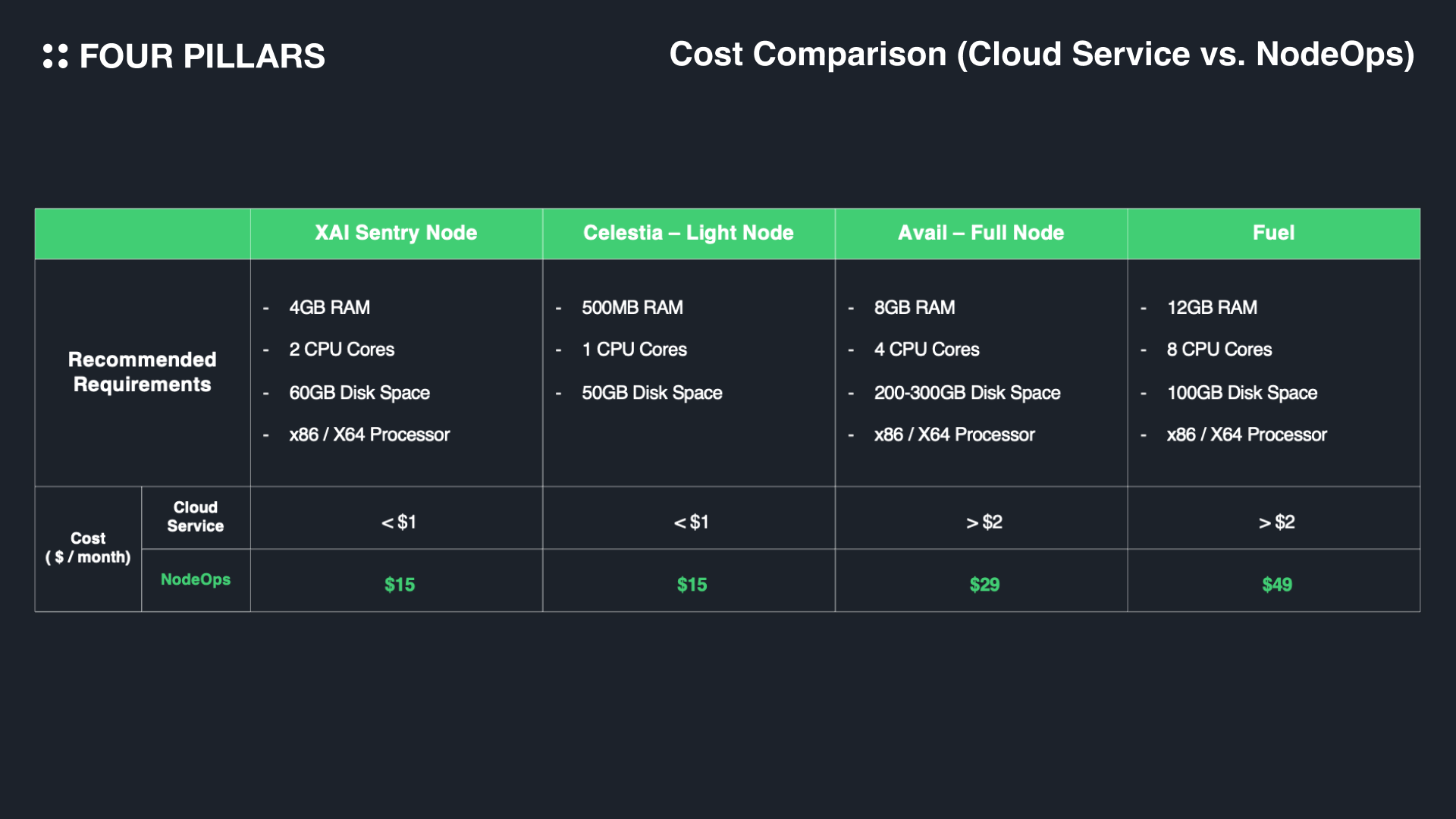
Protocols use NodeOps for various purposes, including assigning necessary nodes for actual mainnet operation or running incentivized testnets. The service fee varies for each node - although it may seem high compared to using separate cloud services, as seen in the table above.
However, when considering the convenience of node setup and operation, along with the services provided by NodeOps such as covering gas fees, building a separate security system to avoid exposing private keys, optimizing uptime, protocol updates, and etc., the cost demanded by NodeOps could be quite reasonable.

Source: NodeOps Discord
All communications regarding protocol-specific announcements, new node additions, Q&A, and bug bounties are conducted through its Discord server. Service users are assigned roles related to the nodes they are participating in and can freely communicate within their separate channels.

Source: https://archway.nodeops.xyz/
Besides node setup, NodeOps supports various features, including AI-based chatbots and a playground for codebase testing for product builders. This allows builders to understand and test developer documentation and test codes for some of the integrated protocols on NodeOps comprehensively.
Other platforms similar to NodeOps in terms of functionality, UI/UX, cost, and operational policies include Mintair, NodeShark, Nodigy. Although the range of protocols supported by each platform varies, NodeOps is unique in supporting a wide variety of node types within a single protocol. More and more protocols are partnering with these platforms primarily for a variety of uses, such as for decentralized operations or to run incentivized testnets to try out various tests ahead of major updates.

Source: Dappnode
Actually, Dappnode and Avado* are considered pioneers in node setup/maintenance services. Unlike the projects mentioned earlier, these services sell hardware that includes a software package for setting up and synchronizing nodes for specific protocols in a plug-and-play manner, or sell the hardware alone for users to customize the software package (Avado is also developing a node setup service in a cloud environment similar to the earlier projects).
In contrast to subscription-based operational costs through previous services, purchasing hardware devices of Dappnode or Avado incur a one-time cost (i.e., the purchase price of the hardware device) and a small monthly-charged electricity fee.
The price of a hardware device ranges from 1,000 to 2,000 euros. However, considering that a single device can host more than 2~4 nodes and the costs of cloud service fees and labor, the price is not unreasonable.

Source: Dappnode Docs
Once a Dappnode or Avado device is installed at home and connected to a router, users complete basic settings, including account and VPN setup, through a separate interface provided by each service. Then, following the guide for the desired protocols, users install the software package, generate a Validator Key, and deposit native tokens - with each Validator Key being generated through a mnemonic phrase in Wagyu and the record being stored in the protocol's block.
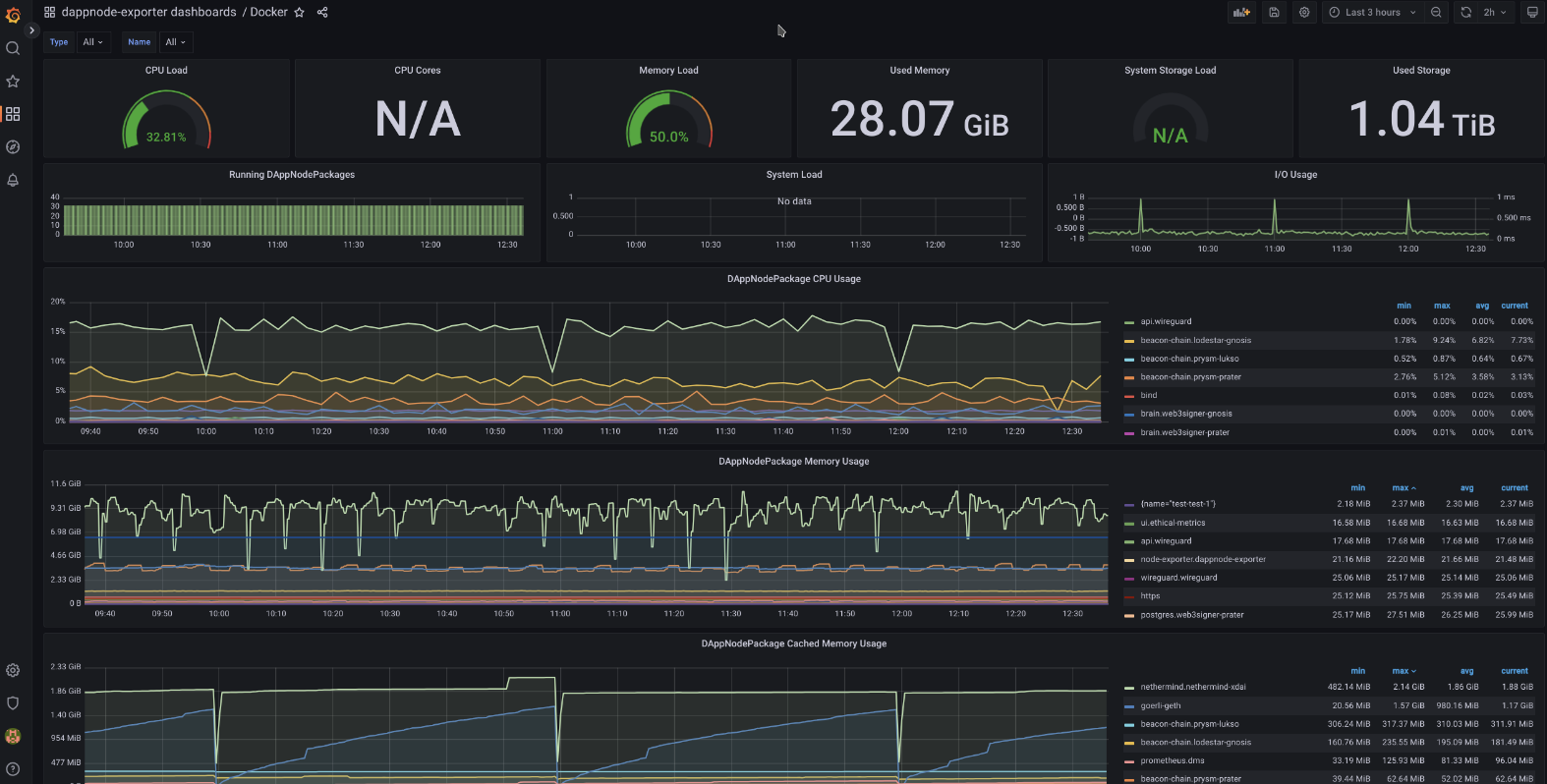
Source: Dappnode Docs
Also in case of Dappnode, it integrates performance monitoring tools like Prometheus and Grafana on DMS(Dappnode Management Service), allowing node operators to monitor their nodes' operation effectively.

Source: Dappnode
Currently, Dappnode supports operating nodes for Ethereum, Gnosis, and LUKSO, while Avado supports Ethereum, Near, and Avalanche.
Since their inception in 2018, both services have been particularly unique in offering Ethereum staking options, allowing users to easily solo stake with 32 ETH or activate staking in LSD Pools such as Rocket Pool, Stader, Stakewise, and Stakehouse with smaller amounts. Additionally, users can explore more stable revenue options for node operation by customizing codes of provided software package to utilize MEV Boost or integrating the Obol Network's DVT package*.
*Dappnode recently launched an MEV Pool service called Smooth, which gathers solo stakers to collectively capture MEV opportunities and distribute the earnings among the participating solo stakers.
Thanks to Kate for designing the graphics for this article.
Dive into 'Narratives' that will be important in the next year